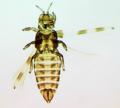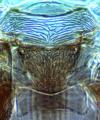Dendrothrips ornatus
Recognition data
Distinguishing features
Both sexes fully winged. Body and legs brown, pronotum with yellow markings, hind tarsi and antennal segments III–V yellow; fore wing banded, dark at base and apex and with two dark and three white transverse bands. Antennae 8-segmented but segment VI with a partial suture producing a 9-segmented condition; segments III–IV with sensoria forked. Head and pronotum with no long setae. Metanotum with elongate reticulation, median pair of setae small and arising medially. Metathoracic furca lyre-shaped, extending into mesothorax. Tarsi all 1-segmented. Fore wing apex bluntly rounded, antero-marginal cilia arising ventrally behind apparent margin, setae minute, postero-marginal cilia straight. Abdominal tergites II–VIII median setae long and close together; lateral thirds of tergites with complex sculpture; VIII with short postero-marginal comb of microtrichia. Sternites III–VII with three pairs of small postero-marginal setae.
Related and similar species
There are 52 species listed in the genus Dendrothrips, none of which is native to any part of the Americas. Most of them are known from Africa, Asia and Australia, but with nine species from Europe (zur Strassen, 2003). These species all have the metathoracic furca elongate and "lyre-shaped" as in other members of the Dendrothripinae (Mound, 1999). However, in Dendrothrips species the forewing is unusual with the antero-marginal cilia arising ventral to the apparent anterior margin.
Taxonomic data
Current valid name
Dendrothrips ornatus (Jablonowski)
Original name and synonyms
- Thrips ornatus Jablonowski, 1894: 93
- Dendrothrips tiliae Uzel, 1895: 160
- Dendrothrips schillei Bagnall, 1927: 568
Family placement
Thripidae, Dendrothripinae
Common names
Privet thrips
Biological data
Life history
Larvae and adults feed on the leaves of the host plant, but they seem to be associated with older leaves, not with the young buds. Pupae can also be found on the leaves.
Host plants
Ligustrum, Syringa, and possibly Fraxinus (Oleaceae).
Tospoviruses vectored
None
Crop damage
Sometimes causing leaf damage to privet, cultivated Ligustrum species.
Distribution data
Area of origin
Probably southern Europe
Distribution
Widespread in Europe; introduced to North America, but with few records from California.







